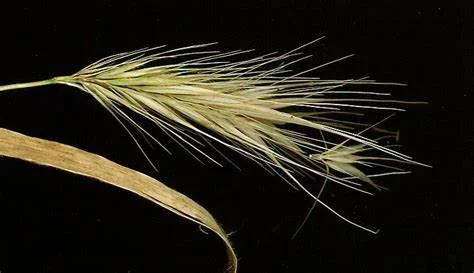Foxtails: A Hidden Danger to Your Dogs 🌾🐶
Foxtails are grassy plants with long, spiky, barbed seeds that resemble tiny fox tails.
Harvey at the vet this morning.
After living in the Texas Hill Country for over four years, we were surprised to discover something we had never encountered here before — foxtails. Today we had to make an emergency visit to the Kendall Country Veterinary Center with our 12.5-year-old Hungarian Vizsla, Harvey, because of a painful abscess in his jaw/neck, about the size of an orange. Initially, we thought he had swallowed a wasp and had been treating him with Benadryl. However, after discovering foxtails on our property, we quickly realized the real culprit. This experience reminded us of the dangers foxtails can pose to our furry friends, and we want to share what we’ve learned with you.
What Are Foxtails? 🌿
Foxtails are grassy plants with long, spiky, barbed seeds that resemble tiny fox tails. These seeds easily detach from the plant and can become a real hazard for your dog, especially during the warmer months. While they may seem harmless, their sharp and barbed nature makes them dangerous when they come into contact with your dog.
Why Are They Dangerous? ⚠️
Foxtails are highly dangerous because of their unique arrowhead shape. Once the seeds come loose, they can get stuck in your dog's fur, eyes, ears, nose, or paws. These barbed seeds can travel through the body, potentially leading to serious infections or even worse. Here’s how foxtails affect your dog’s health:
Ears 👂: A foxtail seed can lodge deep in the ear canal, causing intense pain, infection, and possible hearing loss.
Eyes 👀: If a foxtail gets into your dog’s eyes, it can cause redness, irritation, and even corneal damage if left untreated.
Paws 🦶: Foxtails can embed themselves in your dog’s paws, leading to limping, swelling, and discomfort.
Nose 👃: Dogs often sniff around everything, and a foxtail seed in the nose can lead to sneezing, nasal discharge, or respiratory infections.
Signs Your Dog Has Encountered Foxtails 🚨
After our experience, we now know how important it is to spot foxtails early. Watch for the following signs:
Shaking head or pawing at ears (if it’s in their ear)
Squinting or watery eyes, or excessive pawing at the face
Limping or favoring one paw
Sneezing, coughing, or nasal discharge
Unexplained swelling or redness in areas where seeds may have lodged
What to Do If You Find a Foxtail on Your Dog 🐾
Stay Calm: First, keep your dog calm and prevent them from rubbing or pawing at the affected area.
Inspect Your Dog: Check their fur, ears, eyes, paws, and nose. If you find a foxtail, gently remove it. If it’s embedded deeply, don’t attempt to remove it yourself.
Call the Vet: If the foxtail is deep or causing signs of infection (like swelling, redness, or pain), it’s time to visit the vet. In our case, Harvey’s abscess required immediate veterinary care to ensure proper treatment.
How to Prevent Foxtail Injuries 🛑
Regular Grooming: After walks, brush your dog’s fur to remove any foxtails that may have attached themselves.
Keep an Eye on Walks: Avoid areas with dense foxtail growth, particularly during late spring and summer when they’re most active.
Check for Foxtails: Before letting your dog back inside, give them a thorough check for any foxtails that may have hitchhiked into your home.
Conclusion
After discovering foxtails on our own property and experiencing the stress of an emergency vet visit, we’re sharing this information to help keep your dogs safe. These plants are more than just an inconvenience — they can be a serious health risk. By staying vigilant and taking proactive steps, you can protect your furry friends from the hidden dangers of foxtails. Keep your dogs safe, and don’t let foxtails sneak up on you.


